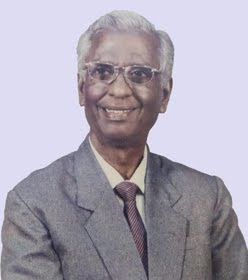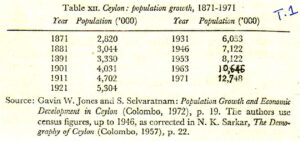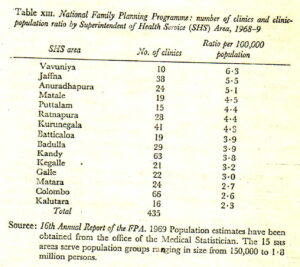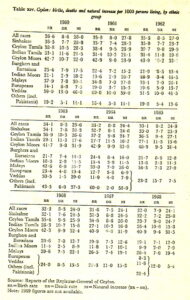An interesting overview by Prof. Shelton Kodikara of ‘Family Planning in Ceylon’
by Sachi Sri Kantha, July 20, 2021
Family Planning in Ceylon (1973) by Prof. S.U. Kodikara

Prof. Shelton Kodikara
Prof. Shelton Upatissa Kodikara (1927-1994) was an authentic Sinhalese academic, whom I respected very much. Sadly, as of now, there is no Wikipedia entry about his contributions to recent Sri Lankan history. His specialty was Indo-Sri Lankan relations. But, I have preserved his review on ‘Family Planning in Ceylon’ (1973), which appeared in an edited book ‘The Politics of Family Planning in the Third World’, published by George Allen & Unwin Ltd., London. The book itself was a borrowed one from the British Council library. Because of its historical significance in the Sinhalese-Tamil political conflict of Sri Lanka, I have transcribed this Kodikara’s review, for digital preservation, and provide it here.
This is a lengthy review – occupying 44 printed pages of an edited book, with 135 footnotes. The editor of the book was Mr T.E. Smith. At the end of the chapter, Prof. Kodikara had stated that he completed writing this review while he was in London. Personally for me, this was one of the early papers I made a photocopy of when I was at the Faculty of Medicine, University of Peradeniya, in late 1970s. That was the time a photocopier was newly introduced to the faculty. Only ONE was in service. Because of repetitive use for official (and ‘unofficial’) purposes, it broke down frequently, and we had to wait in line for a copy to be made. We couldn’t operate the copier personally. The job was specifically assigned to a male office assistant. I guess, I had to pay 10 cents per one copied page. Now, these copied pages have yellowed, with screeching parallel lines decorating these yellowed pages. During the last 40 years of my peregrinations, sometimes I was tempted to throw this document to the waste paper bin. But, since I had paid for 23 pages (2 Sri Lankan rupees and 30 cents – quite an investment at that time!), the frugal self of my Freudian id chided against such a wasteful deed.

Table 1- Ceylon – Population Growth, 1871-1971
This year marks the 150th year of the first population census conducted by the British regime. In 1871, the island population was 2.82 million only. As this Kodikara review contains three tables, I provide the scanned material of these three tables.
Table 1: Ceylon: Population growth, 1871-1971.
Table 2: National Family Planning Programme: number of clinics and clinic-population ratio by Superintendent of Health Service (SHS) Area, 1968-9.

Table 2 – Number of Clinics and clinic-population ratio, 1968-69
Table 3: Ceylon: births, deaths and natural increase per 1,000 persons living, by ethnic group.
This Review had 13 sub sections. Among these, what I found interesting was Kodikara’s summary of the attitudes held by the Buddhist clergy (Sangha), and Other Buddhist organizations such as All Ceylon Buddhist Congress. Kodikara had noted, “In a memorandum to the Constituent Assembly, one member of the sangha even suggested that polygamy be legalized among the Sinhalese in order to maintain the numerical supremacy of the Sinhalese.” The details related to 13 sub sections are as follows:
Economic development and population growth
The organization of family planning services in Ceylon up to 1965
The Family Planning Association

Table 3 – Births, deaths and natural increase per 1,000 persons
Population and Family Planning in the Development Plans, 1955-65
Official Policy after 1965
Policy of the Present Government
The Opposition to Family Planning
Attitudes of the Buddhist Sangha and Other Buddhist Organizations
Minority Religious Groups
Conflicting Attitudes of the Press
The Framework of Family Planning Services in Ceylon
The National Family Planning Programme in Operation
Family Planning and the Decline in the Birth Rate
An Abstract of the Review
Unfortunately, Prof. Kodikara failed to provide an abstract for this review. Somehow, I was able to find one, provided in the 3rd volume of H.A.I. Goonetileke’s ‘Bibliography of Ceylon’ (1976). It is as follows:
“The ups and downs of the concept in theory and practice since the organisation of family planning on an institutional basis in 1953, with the founding of the Family Planning Association. A fortuitous by-product of the youth revolution in April 1971 was a shot in the arm for the program through official patronage becoming available more dramatically than earlier.”
Interesting features in the review
First, views of past Sri Lankan prime ministers, S.W.R.D. Bandaranaike, Sirimavo Bandaranaike, Dudley Senanayake and later-to-be-President R. Premadasa on family planning are included. Others who make cameo appearances on behalf of Sinhalese population were prominent ‘Tamil-baiting’ politicians who held ministerial positions – E.L. Senanayake (1920-2000), I.M.R.A. Iriyagolle (1907-1973), C.P. de Silva (1912-1972). One humorous quip was from Mr. Iriyagolle (who was then the Minister of Education in Dudley Senanayake’s Cabinet), “I am fully against family planning and I consider it murder.” (Ceylon Daily News, March 29, 1968). And, a 1969 hyperbole of future President Premadasa, ‘… the development projects initiated by the Government will need thousands of more people to man them. What is presumably needed is an increased birth rate instead of birth control,’ (The Sun, November 11, 1969) needs mention, too.
Secondly, the leading campaigner against family planning was rabble-rousing Buddhist monk, Madihe Pannasiha Thero (1913-2003) of Amarapura sect. Prof. Kodikara had presented this monk’s extremist views as follows: “On the hypothesis that only Sinhalese would practice birth control, the Reverend Pannasiha argued that, given the current trend in birth rates, Tamils would outnumber the Sinhala population by AD 2114 and that Muslims would also outnumber the Sinhala population by AD 2121. By AD 2135, it was argued, Muslims would become the major race, Tamils the second, and Sinhalese would be relegated to third place…It seems futile to attempt any appraisal of the validity of population projections extending so far into the future, especially those made on such hypothetical grounds.”
Thirdly, I disagree with Prof. Kodikara’s inference that the conservative groups relating to family planning practice were “Tamils of the north and east”. Rather, the very conservative groups in the island were Muslims and Roman Catholics. Prof. Kodikara himself had provided details for such conservatism in the subsection on Minority Religious Groups.
Fourthly, one demerit in the review was Prof. Kodikara’s repetitive citation of a report by G. Nycander, a Swedish adviser on family planning in Ceylon. Footnote 53 indicates that this 1971 report is an unpublished mimeograph. No other details, such as its availability for other researchers or the number of pages, are provided.
References
Forbes R. Prof. Shelton Kodikara. Lanka Guardian, Nov. 15, 1994; 17(14): 4.
Goonetileke, H.A.I. entry 2477, A bibliography of Ceylon (Sri Lanka), vol. III, Interdocumentation Co., Zug Switzerland, 1976, p. 186.